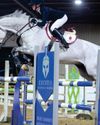
DENTAL extraction can appear daunting to an owner. When performed by a suitably qualified and skilled clinician, however, with the correct equipment, it can be a routine procedure. The most common reason for removal of a molar tooth is infection of its roots, termed apical infection.
Signs of infection can vary. Generally, infection of mandibular (lower) cheek teeth creates a swelling on the bottom of the jaw, which may burst out into a draining tract (a surface wound). Apical infection of the front maxillary (upper) cheek teeth usually causes swelling in front of the facial crest – the bony ridge either side of the face. Because the back maxillary teeth have their roots within the sinuses, infection typically causes nasal discharge.
Teeth may become apically infected or require extraction as a result of fracture, advanced dental caries (decay), periodontal (gum) disease or a blood or lymphaticborne tooth infection. Signs may be subtle, ranging from quidding in the case of infection to tenderness over a facial swelling. Occasionally, a “dead” tooth with open pulps (the soft, central area) is only identified during routine dental examination.
A detailed oral exam under sedation can give clues as to which tooth is involved, by identifying fractures, open pulps, dental caries and periodontal disease. This will also provide information about the infected tooth, notably the integrity of its crown and whether the tooth is mobile.
Radiography (X-rays) are used to examine the roots of the cheek teeth and the surrounding structures. Advanced imaging such as computed tomography (CT) can be useful in cases where radiography and oral examination fails to reach a diagnosis.
This story is from the {{IssueName}} edition of {{MagazineName}}.
Start your 7-day Magzter GOLD free trial to access thousands of curated premium stories, and 9,000+ magazines and newspapers.
Already a subscriber ? Sign In
This story is from the {{IssueName}} edition of {{MagazineName}}.
Start your 7-day Magzter GOLD free trial to access thousands of curated premium stories, and 9,000+ magazines and newspapers.
Already a subscriber? Sign In

'Sorry, but I wasn't feeling it'
Fresh from the opening meet, Tessa Waugh hasn't quite yet been bitten by the hunting bug. Without the crisp autumnal air and cheek-pinching cold she hoped for, it's a sluggish start

New pair pull off a win
A former European Championships pony is on form with his new rider, while elsewhere former showjumpers and eventers take ribbons

Lording it over the rest
Horses who have returned from injury, a second generation homebred and a long format specialist score on the final weekend of the British season

Smith hits flying form
A \"her way or no way\" mare helps Zoe Smith to an impressive ribbon haul and a rider beats his own boss to the top spot

Jankorado hits the jackpot
Paul Sims is triumphant despite his interrupted jump-off preparation and a borrowed horse comes up trumps

Peanut
From \"dangerous, scary\" to hedge-hopping brilliance, hunting has been the making of this unstable but very lovable equine character

She's a corker
Communication, says long-standing and highly respected Belvoir master Lady Sarah McCorquodale, is the key to all, as Catherine Austen discovers

Access all areas Cavalier Centre
The Cavalier Centre is a fully accessible, state-of-the-art equestrian centre designed to improve lives through horse-based activities. Ellie May Forrester pays a visit

'Use it or lose it'
Not everyone wants to reach for the pipe and slippers at a certain age. Becky Murray speaks to some veteran horse-and-rider combos for their secrets of human and equine longevity

A new way forward
Worm control in horses is vital, but established methods will not remain effective for much longer. Tim Mair FRCVS explains why and how we need to change